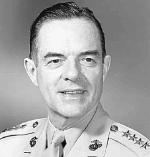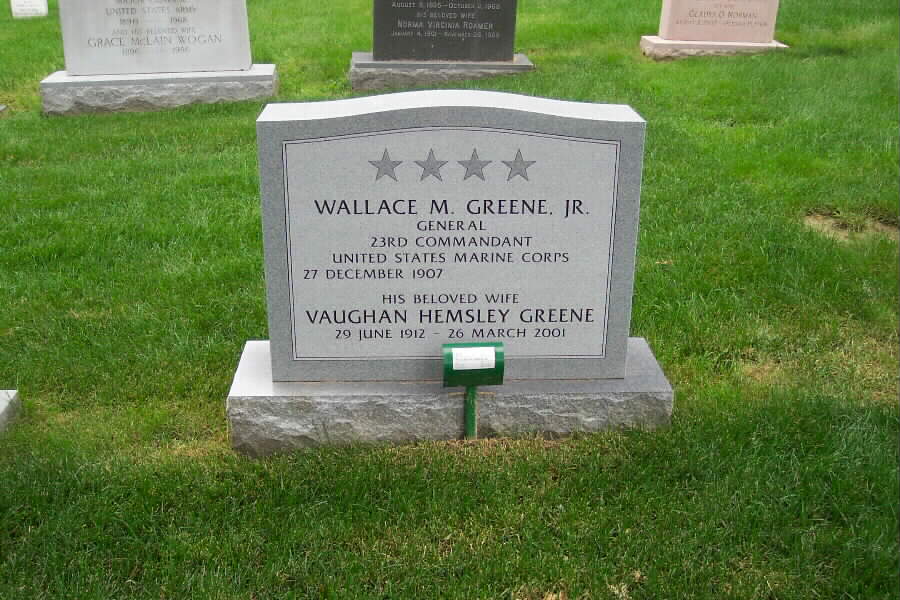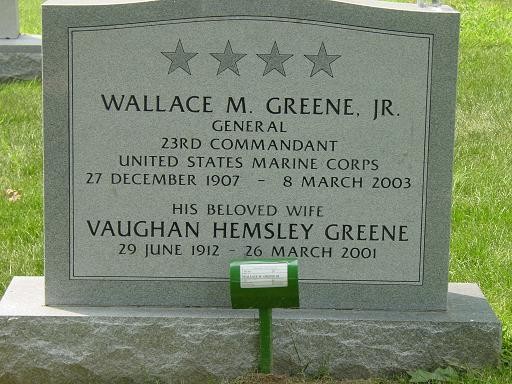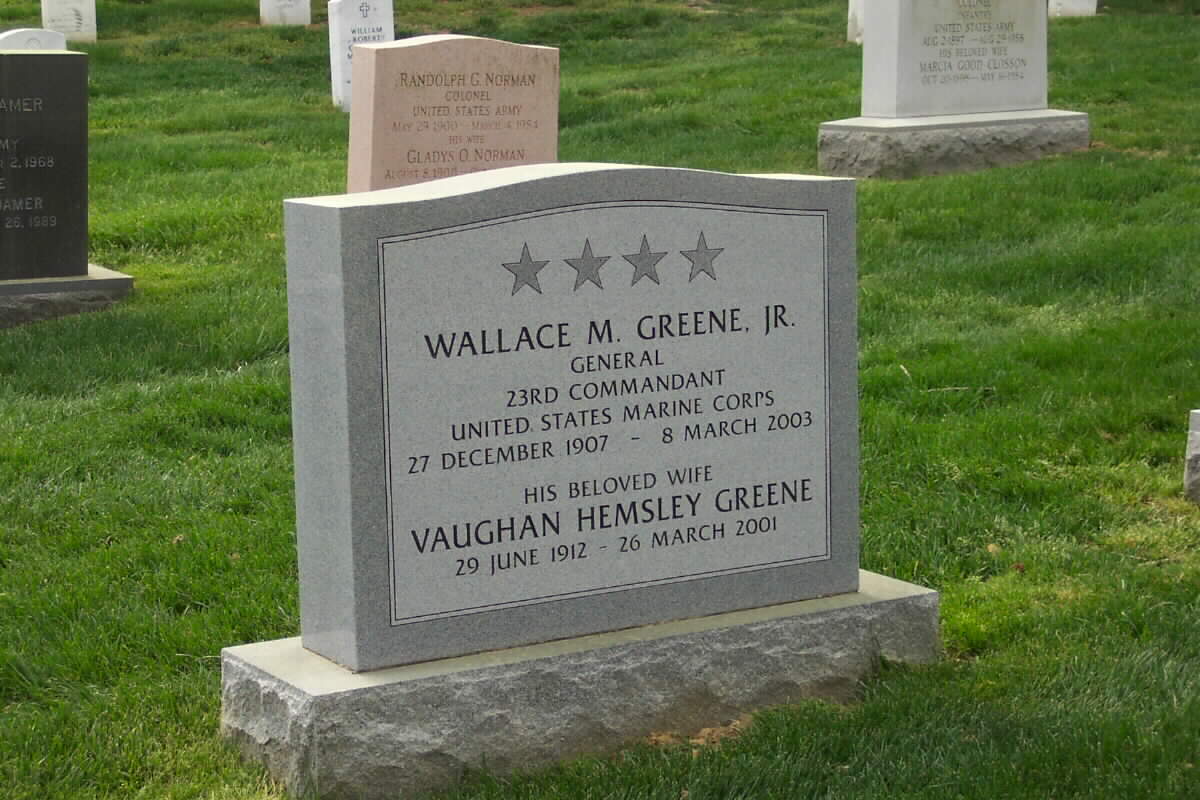From a contemporary press report:

During a 37-year career that took him to China in the 1930s and to London and the South Pacific in World War II, General Greene gained a reputation as a brilliant staff officer, long-range planner and troubleshooter. He was commandant from 1964 through 1967. In March 1965, when President Lyndon B. Johnson ordered U.S. combat troops to what was then South Vietnam, a Marine regiment was the first American combat unit to enter the country. The U.S. presence eventually grew to 500,000, of which about 70,000 were Marines. Under General Greene, the Marine Corps itself grew from 178,000 active-duty personnel to nearly 300,000.
As Chief of Staff of the Marine Corps and then as Commandant, General Greene sponsored and encouraged a small group of officers to brainstorm a look 20 years into the future to see what a modern battlefield might be like and what it would require. The result was a study called MarCor 85, and its broad outlines are part of Marine Corps doctrine today.
A key proposal was training individual infantrymen to spot targets and use satellite positioning and “terminal guidance” systems to call in artillery, airstrikes or rockets. These techniques have been used by Marines and special forces in campaigns from the Gulf War in 1991 to Afghanistan.
Wallace Martin Greene Jr. was born in Waterbury, Vermont, on December 27, 1907. He was a descendant of Nathaniel Greene, the Revolutionary War hero. He attended the University of Vermont for a year before entering the U.S. Naval Academy at Annapolis. He graduated in 1930 and was commissioned a Second Lieutenant in the Marine Corps.
His early assignments included sea duty aboard the battleship Tennessee and a period studying chemical warfare at Edgewood Arsenal in Maryland. From 1937 to 1939, he was stationed with the Fourth Marine Regiment in Shanghai. This was the period of Japan’s expansion into China, and the Marines helped to provide security to the International Settlement.
In World War II, General Greene was a naval observer in London and then a staff officer in American Samoa. In 1944, he helped plan operations in the Marshall Islands and the invasions of Saipan and Tinian in the Mariana Islands.
In the postwar years, General Greene graduated from the National War College and had assignments at the Quantico Marine Corps Base, Marine Corps headquarters in Washington, Hawaii and elsewhere and on the staff of the Joint Chiefs of Staff.
In 1956, General Greene was ordered to the Marine recruit depot at Parris Island, South Carolina. Six recruits had drowned during an unauthorized night training march. The tragedy shook the Marine Corps to its institutional and cultural foundations.
General Greene was put in charge of recruit training at the base and later served as commanding general of the base itself. He put an end to such long-standing practices as mass punishments and physical abuse of recruits.
In 1958, General Greene was ordered to Marine Corps headquarters. In 1960, he was named Chief of Staff, the number 2 position in the Corps at that time. In October 1963, he was nominated by President John F. Kennedy to be Commandant. He was confirmed by the Senate and took office on January 1, 1964.
In addition to meeting the requirements of the war in Vietnam, General Greene centralized and reorganized the management of personnel and equipment. He served until December 31, 1967, and then retired. He was a longtime resident of McLean, Virginia.
General Greene’s military decorations include two awards of the Distinguished Service Medal and two awards of the Legion of Merit, both with the combat “v” device.
General Greene’s wife, the former Vaughn H. Emory, whom he married in 1931, died in 2001.
Survivors include a son, Wallace M. Greene III, a retired Marine Lieutenant Colonel, of Arlington, Virginia, and a daughter, Vaug.
Marine Corps General Wallace Martin Greene Jr., who commanded his service from 1964 to 1967 as its 23rd Commandant, died on March 8, 2003, at Goodwin House in Alexandria. He was 95.
Greene served at the Little Creek Naval Amphibious Base in Virginia Beach in the early 1950s. His 37-year military career, beginning with World War II, culminated with his leadership of the Marine Corps during the Vietnam War, when it grew from 178,000 to nearly 300,000 personnel. He retired on December 31, 1967, and made his residence in Northern Virginia.
Greene gained a reputation as a strong staff officer, long-range planner and troubleshooter.
Born on December 27, 1907, in Waterbury, Vermont, he was a descendent of Nathaniel Greene, a Revolutionary War hero. He attended the University of Vermont for a year before entering the United States Naval Academy, graduating in June 1930 when he was commissioned as a Second Lieutenant.
Stationed in London in 1941, he served as a special naval observer of commando training and attended the British Amphibious Warfare School and the Royal Engineer Demolitions School.
As a Lieutenant Colonel, he served as Assistant Chief of Staff for the 5th Amphibious Corps in 1943, earning the Legion of Merit with combat “V” for his part in planning and executing the Marshall Islands invasion. He received a similar award the next year while with the 2nd Marine Division for the planning of the Saipan and Tinian operations.
He served at Little Creek and graduated from the National War College in 1953, then became staff special assistant to the Joint Chiefs of Staff for national security affairs in Washington.
Promoted to Brigadier General in 1955, he served as Assistant Division Commander, 2nd Marine Division. In 1956, he was suddenly transferred to Parris Island, South Carolina, to straighten out the aftermath of the Ribbon Creek incident. Six recruits had drowned during an unauthorized night training march.
Greene put an end to the long-standing practice of ordering mass punishments and physical abuse of recruits.
The next year, he took command of the Recruit Depot and later became commanding general of the Marine Corps Base at Camp Lejeune, North Carolina.
Nominated by President John F. Kennedy, he became the Marine Corps Commandant on January 1, 1964, with the four-star rank of General.
During his tenure as commandant, he encouraged a small group of officers to look into the future and imagine what a battlefield would look like. The project, called “MarCor 85,” resulted in many of the satellite positioning and training devices that remain in use as part of Marine Corps doctrine today.
Survivors include a daughter, Vaughn E. Greene, and a son, Wallace M. Greene III of Alexandria, a retired Marine Corps Lieutenant Colonel.
Funeral services will be held at 12:45 p.m. April 3 at the Old Post Chapel in Fort Meyer, Virginia. Interment, with full military honors in Arlington National Cemetery, will immediately follow the service.
In lieu of flowers, donations may be sent to: Catholic Charities of Arlington, 200 North Glebe Road, Arlington, Virginia 22203.
General Greene is buried in Section 30 of Arlington National Cemetery. His wife, Vaughan Helmsey Greene (29 June 1912-26 March 2001) is buried with him.
General Wallace M. Greene Jr., who commanded the Marine Corps early in the Vietnam War, died last Saturday in Alexandria, Va. He was 95.
General Greene was promoted to four-star rank and commandant of the corps in 1964, when American marines in Vietnam numbered only in the hundreds. But the buildup of United States combat units, as opposed to the military trainers who had long been advisers to South Vietnamese forces, began the next year, and by the time he retired at the end of 1967, the number of marines and sailors in the Amphibious Force there approached 100,000, about a fifth of all American personnel engaged in the war.
Involvement in Vietnam was widely challenged by then in an America also torn by social and racial strife. But in public statements and Congressional testimony, General Greene joined calls for broadening already heavy air attacks on North Vietnam.
General Greene left his stamp on the corps with an overhaul of its training and planning procedures. Advances that he outlined remain in today’s manuals, among them those employing up-to-date guidance systems with which marines in the field spot targets and call in artillery or air support.
Wallace Martin Greene Jr. was a native of Waterbury, Vt., and a descendant of the Revolutionary War general Nathanael Greene. He graduated from the United States Naval Academy in 1930 and spent the next 37 years in uniform.
He took part in the invasion of the Marshall Islands in 1943 and was a staff officer in the Second Marine Division for the Saipan and Tinian operations, in the Northern Marianas, the following year. He was then attached to Marine headquarters in Washington and was promoted to full colonel as the officer in charge of the Atlantic Fleet’s Marine training, in Virginia.
There followed tours of duty at Pearl Harbor, at Quantico, Va., at the National War College and, as a newly minted brigadier general and assistant commander of the Second Division, at Camp Lejeune, N.C.
In April 1956, six Marine recruits drowned on a disciplinary night march at Parris Island, S.C., and General Greene served as the senior officer in the resulting inquiry, which led to Brigadier General David M. Shoup’s being named to the new post of inspector general for recruit training.
General Greene then took command at Parris Island and later Camp Lejeune before returning to Washington, where he held operations, training and planning positions and served as chief of staff under General Shoup, whom he succeeded as commandant on Jan. 1, 1964.
His wife, Vaughan Emory Greene, died in 2001 after 70 years of marriage. His survivors include a son, Lt. Col. Wallace Greene III, retired, of Arlington, and a daughter, Vaughan Greene of McLean, Va.
When President John F. Kennedy nominated General Greene for commandant, the general showed himself to be a space-minded planner. He was thinking, he said at the White House, of using rockets to fly marines to combat. That way, he said, it might be possible to send a 1,200-marine battalion from Camp Lejeune to a trouble spot in Africa in 80 minutes, but not until the end of the 1970’s.
On Saturday, March 8, 2003. He is the loving husband of the late Vaughn H. Greene; father of Vaughn E. Greene, McLean, Virginia, Lieutenant Colonel Wallace M. Greene III, USMC (Ret.), Arlington, Virginia; father-in-law of Gretchen Textor Greene; brother of Major John S. Greene USA (Ret.); grandfather of Wallace M. Greene IV of Alexandria, Virginia, Gregory E. Greene, Houston, Texas, and Elizabeth Greene Featherstone, Vienna, Virginia. Also survived by two great grandchildren.
Mass of Christian Burial will be offered on Thursday, April 3, at Fort Myer Old Post Chapel at 12:45 p.m. Interment with full honors at Arlington National Cemetery. In lieu of flowers memorial contributions may be made to Catholic Charities of Arlington, VA, 200 N. Glebe Rd, Suite 506, Arlington, VA 22203.

Michael Robert Patterson was born in Arlington and is the son of a former officer of the US Army. So it was no wonder that sooner or later his interests drew him to American history and especially to American military history. Many of his articles can be found on renowned portals like the New York Times, Washingtonpost or Wikipedia.
Reviewed by: Michael Howard


